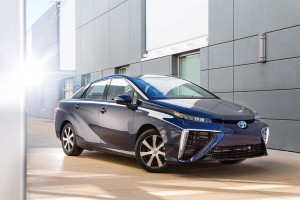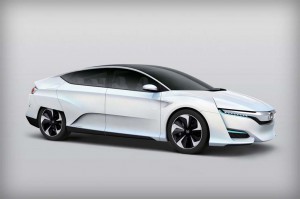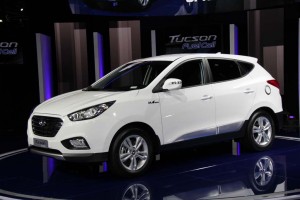
Toyota announced it would begin selling its Mirai hydrogen fuel car in Japan this year and the rest of the world in 2015.
Declaring plans to be “at the leading edge,” Toyota says it will launch its new hydrogen-powered Mirai next month, bringing its first fuel-cell vehicle to market a bit ahead of its original schedule.
Honda, meanwhile, revealed an updated prototype of the hydrogen car it plans to bring to market, though its own plans may be slightly delayed. Nonetheless, it would join not just Toyota but also Hyundai in marketing the alternative powertrain technology that advocates claim could sidestep the limited range and other problems faced by today’s battery-electric vehicles.
“In time, the fuel cell vehicle will become mainstream. We wanted to take the first step,” declared Mitsuhisa Kato, a Toyota executive vice president, at Mirai’s launch in Tokyo. “We want to be at the leading edge.”
For now, Toyota’s goals are far less than mainstream, however. It will start selling the Mirai in Japan on Dec. 15, with dealers in Europe and the U.S. to get the hydrogen car in mid-2015. The Japanese giant expects to sell only about 400 in Japanese during the first year and another 300 elsewhere.
But advocates of hydrogen power note that sales of the original Toyota Prius hybrid were miniscule at first. The familiar gas-electric model is now the world’s best-selling hybrid and was, in 2013, the number one-selling vehicle of all kinds in green-minded California.
Several factors are likely to limit the appeal of the Toyota Mirai, at least initially. For one thing, it will initially sell for 6.7 million yen, or $57,600, in Japan. An even bigger hurdle is the lack of a hydrogen refueling infrastructure. There are only a handful of pumps today, one reason that Toyota – like Honda and Hyundai – will initially limit U.S. sales to the Southern California market.
But regulators in California, as well as in Japan, Germany and some other parts of the world, are pressing to expand the availability of the lightweight gas in a bid to increase the appeal of hydrogen power.
The fuel-cell was first conceived in the mid-1800s, but it took until the Apollo moon mission to see it put to serious, practical application. At its most basic, a fuel-cell “stack” combines compressed hydrogen gas with oxygen from the atmosphere. That process creates only water vapor in its exhaust – and current that can be used to run an electric motor, much like a battery car.
The advantage over an electric vehicle like the Toyota RAV4-EV is that Mirai’s tanks will hold enough fuel to travel up to 300 miles, at least twice the range of the typical battery car. And while recharging a RAV4-EV can take hours, Toyota says Mirai can be refueled in less than five minutes. Those factors make it more on a par with a conventional gasoline-powered vehicle, according to Toyota.
Mirai means ”future” in Japanese, and the maker has strongly argued that hydrogen power, rather than battery power, is likely to become the alternative power technology of choice.
(Affordable hydrogen could send sales of fuel-cell vehicles soaring. For more, Click Here.)
While rivals, notably California-based Tesla Motors, would beg to disagree, Toyota’s position is backed by several other manufacturers – notably including Hyundai, which began selling a fuel-cell version of its Tucson crossover-utility vehicle last summer in the U.S.
(Click Here for details about Toyota taking ALG’s residual value award.)
Honda will join the emerging segment sometime when it launches its own new new hydrogen car, though it appears it will push back its own launch until March 2016. It actually lays claim to have marketed the first commercial fuel-cell vehicle, a few years back, in the form of the Honda FCX Clarity. It’s not clear if the new model will carry on that name.
(To see more about GM’s ongoing labor issues in Colombia, Click Here.)
Like Toyota, Honda debuted a hydrogen car at the 2013 Tokyo Motor Show. On Monday it revealed the latest iteration of the vehicle’s design. It also noted the potential for owners to use the vehicle to provide back-up power for a home. That could prove a selling point to buyers in earthquake-prone Japan and California.
Honda suggested that the final version of its hydrogen car will produce about 100 kilowatts of energy, about 135 horsepower, and also deliver 300 miles on a tank under normal driving. It has not yet announced the price of the upcoming model.



Why on earth would anyone design the front of a vehicle to look like that mess on the Mirai? I think fuel-cell cars may have a strong future but I sure as Hell would never buy anything that FUGLY no matter what it uses for power.